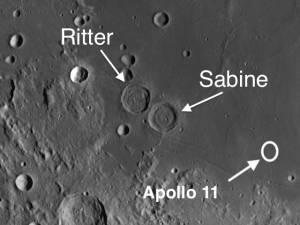The week of January 22-28 takes us from Day 5 to the end of Day 11. This week we will highlight the craters Arago, Sabine & Ritter, viewable on Monday night. (If the terminator is too close to see the inner details, wait until Tuesday.)
 Arago: [NE/J12] About 50 miles from the western shore of Tranquillity you will find the crater Arago (16 mi. in diameter). This is an unusual crater. In the place of a central peak you will see a substantial ridge that extends from the center of Arago’s floor to its northern rim. The evidence suggests that there was a significant collapse of rim material which simply merged with the central peak about eight miles away!
Arago: [NE/J12] About 50 miles from the western shore of Tranquillity you will find the crater Arago (16 mi. in diameter). This is an unusual crater. In the place of a central peak you will see a substantial ridge that extends from the center of Arago’s floor to its northern rim. The evidence suggests that there was a significant collapse of rim material which simply merged with the central peak about eight miles away!
 Sabine & Ritter: [NE/J11] Sixty miles west of the Apollo 11 landing site you will see two curious craters: Sabine and Ritter. They are unusual because they should be deeper than they are. Look closely at Sabine (the easternmost) and you will see that its shallow floor looks like it has been cut out by a giant cookie cutter. Both Sabine and Ritter are floor-fractured craters (FFC’s).1
Sabine & Ritter: [NE/J11] Sixty miles west of the Apollo 11 landing site you will see two curious craters: Sabine and Ritter. They are unusual because they should be deeper than they are. Look closely at Sabine (the easternmost) and you will see that its shallow floor looks like it has been cut out by a giant cookie cutter. Both Sabine and Ritter are floor-fractured craters (FFC’s).1
1 A floor-fractured crater is a special type of crater that has been modified by later volcanism, uplift, and consequent fracturing. Some of the common characteristics of FFC’s are that they are large, they have rilles (both arcuate and linear), they occur near the borders of maria, and (most significantly) they are very shallow for their size.
Floor-fractured craters have a fascinating genesis. Some time after the crater was formed and had settled in, magma rising up from underneath the basin actually pushed the crater floors upward (hence their shallowness). It was not an effortless process and the resulting strain caused radial and concentric fractures to appear on the floor. At times, lava would also flow upward through these fractures and spill out onto the crater floor. (Examples: Taruntius [Day 4; NE/J14], Petavius [Days 2-3; SE/M16], Sabine [Day 6; NE/J11], Pitatus [Day 8; SW/M8]).
======================
It is highly recommended that you get a copy of Sky and Telescope’s Field Map of the Moon, the very finest Moon map available for use at the telescope. It is available for $10.95 at www.skyandtelescope.com and on Amazon. All features mentioned in this blog will be keyed to the grid on the Field Map and will look like this: Plato: [NW/D9]
Credits:
Courtesy of Gray Photography of Corpus Christi, Texas
Lunar photos: NASA / USGS / BMDO / LROC / ASU / DLR / LOLA / Moon Globe. Used by permission
- Rupes Cauchy: A Best Known Fault on the Moon - July 22, 2024
- Moon Crater Schickard – Crater Floor has Stripes - July 15, 2024
- Moon Craters Langrenus and Vandelinus - July 8, 2024